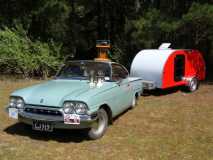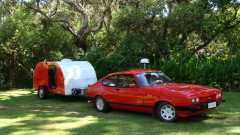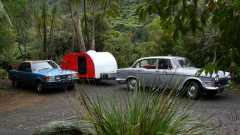capnTelescope wrote:The [tambour] doors still need handles/knobs/puller-uppers/whatever-you-want-to-call-them.
Next project is plumbing propane to the stove/oven and taking care of a couple of details on the stove slideout.
So that's what I've been working on.
The propane plan is to put a 20# bottle in the tongue box, regulate it down to 30psi, run it through a 1/2" black iron pipe under the floor to the galley, up through the floor, and then to the slider with the stove and oven. One of the posts in the plumbing and propane leads me to believe that will be enough pressure for the disposable bottle appliances, using their own regulators.
My trailer manufacturer thoughtfully provided holes through the frame for the pipe. After threading the pipe through the frame, I drilled the hole in the floor, and fitted the aft end fittings:

There are(at least) two kinds of thread sealant goo for piping. There's the white stuff for water pipes, and there's this yellow goo and yellow teflon tape for flammable gases. I know the yellow tape is quite a bit thicker than the white, but I'm not sure what the difference is in the yellow goo.
The aft end sub-assembly:

The nipple and end cap install pointed down. That bit is called a "drip leg." Current building codes and practices require the drip leg for gas appliances in a home to catch dirt, water or other stuff you don't want plugging up your orifices. If it's good enough for my house, it's good enough for the Tear. It's probably part of the Ecuadorian Conspiracy to make things cost more and send us all into poverty. Or, they're in cahoots with the plumbers of the world. Either way, the rest of us lose.
With that, I threaded the long pipe into the tee and tightened from the front:

KCStudly wrote:Soapy water test, for sure on your propane. Just your luck something bad might happen.
As is often the case, KC is right. So I prepared to test for leaks. First step is to fit up the front end to allow a connection to the air compressor and plug up the holes in front.

The brass fitting is a quick disconnect for the air line. There are two connection points here, one for the tank and one for an external hookup. Those will get fitted later.
Here's coming up through the floor.

Needs caulking underneath. I just used a PVC pipe cap here for testing.
I hooked up the compressor line, set it's regulator wide open to 120 PSI, and got out the soapy stuff. All the joints tested good first try. Ditto after leaving pressure on overnight. This is a 4X operating pressure test, so I'm optimistic.
I've been pondering since LCG IX, last October, what to do about the stove/oven slideout:

In my haste to get ready for LCG, I managed to cut the face piece in front of the stove too short by an eighth. Then decided to try it out before doing anything about it. On the LCG trip, the piece broke at the hole for the barrel nut, and I didn't like the restricted access to the burner controls. So redesign is in order, but what? Inspiration finally hit me on Saturday.
I had been thinking putting a piece across the bottom front of the tray. That would give me another chance to cut too short, plus another piece to finish. Too much work. Then I realized I already had the solution for only a couple of saw cuts and a few drilled holes:

Cut the skinny bits off, screw down through the aluminum shelf and install the pocket screws as originally planned.
Clamping up and preparing to screw:

Done!

The unfinished area where i cut off the skinny parts doesn't even show.
I also hadn't screwed down the oven since I didn't account for the regulator having to stick out when I cut the aluminum for the oven shelf. I knew it was going to be a major PITA, so I just said, "Don't screw it!"

So I had to move the 4 screw holes 1-1/2 inches to the right:

It did, in fact, turn out to be a major PITA, but I got 'er done:

The screws sticking up along the bottom front of the oven were another major concern, which I fixed by putting a piece of wood along the front to cover the screws.
The tambour puller-upper knobs were next. I wasn't completely happy with the ones I made for the galley on the saw. Tried a different technique there, on the saw again. Made 7 pieces, liked none. The obvious solution is to do them on the CNC. Here I was able to gain some "experience" in holding small workpieces. Made 8 pieces, liked six, needed six.

They need staining and gluing on. I might redo the ones in the galley.
Waiting for more propane plumbing parts,
Thanks for stopping by!

*********************************************************
(EDIT) 7/2/15
I got an excellent question about the propane setup from ukewarrior. Here's my reply:
Hi David,
Thanks for reading my build journal.I hope you've enjoyed it.
I guess I'm asking if there are two regulators going to the stove (not the oven).
The short answer is "Yes." First, the propane goes to a 30 psi regulator(see below), to the plumbing, to the stove's original stock regulator, to the stove. The stove's regulator is built into the propane assembly that screws onto the disposable bottle.
capnTelescope wrote:The propane plan is to put a 20# bottle in the tongue box, regulate it down to 30psi, run it through a 1/2" black iron pipe under the floor to the galley, up through the floor, and then to the slider with the stove and oven. One of the posts in the plumbing and propane leads me to believe that will be enough pressure for the disposable bottle appliances, using their own regulators.
BTW, it worked!

From the propane tank, it goes through a
Bayou Classic 0-30 PSI Adjustible Regulator/Hose Assembely which drops the pipe pressure to 30 psi. This is done for fire safety. Better to have 30 psi propane than 200 psi in the pipes. 25-30 psi is enough pressure to work the stock regulators for the stove and oven. From the galley end of your piping, plumb to suit to a male disposable bottle adapter.
RV building codes require a very low pressure (11" WC) propane regulator. These won't work with the stock stove regulator, and there's no workaround if you get this type of regulator.
Hard plumbing is 1/2" black iron pipe. Galvanized piping is thought to flake the galvanizing into the propane stream, eventually clogging your orifices.

The gas orifices in your appliances. Not your personal orifices. Added bonus: Black iron is cheaper than galvanized.

Here's a list of the fittings I used. Starting from the galley end of the piping:
[*]
Anderson Metals Brass Tube Fitting, Coupling, 3/8" Flare x 1/2" Female Pipe[*]Flexible propane hose to suit. 3/8" female flare x 3/8" female flare
[*]Plumb to suit: 3/8" male flare to 1/4" FIP (Female Iron Pipe), same thing as FNPT (Fem Natl. Pipe Thread) HoDePo calls it FIP, Amazon calls it FNPT
[*]From the 1/4 FNPT, attach a
Mr. Heater F273755 1/4" Male Pipe Thread x 1"-20 Male Throwaway Cylinder Thread Fitting[*]Screw the cylinder adapter into your stove's regulator.
[*]Attach the stove's regulator to the stove, as you normally do.
[*]Leak test
[*]Cook
Safety concerns:
[*]
Always shut off and disconnect propane tank before towing your trailer.[*]It's a good idea to shut off the propane tank anytime you're not burning propane, in case of small leaks.
[*]I can't say whether or not this setup is legal in your or any other state.
Thanks for your question. I hope this helps.

(/EDIT)






 Frank
Frank


 Frank
Frank

 I'm very happy with how well they turned out.
I'm very happy with how well they turned out.
 Many thanks to all of you following the build.
Many thanks to all of you following the build. 

 I knew you had to be out there lurking.
I knew you had to be out there lurking.  Keep on keeping on.
Keep on keeping on. 












